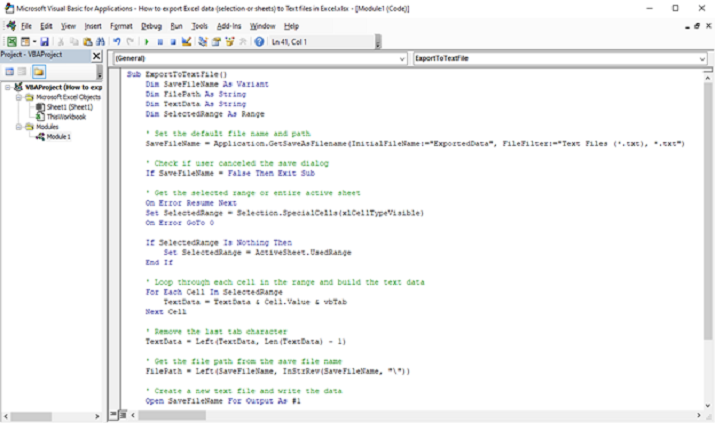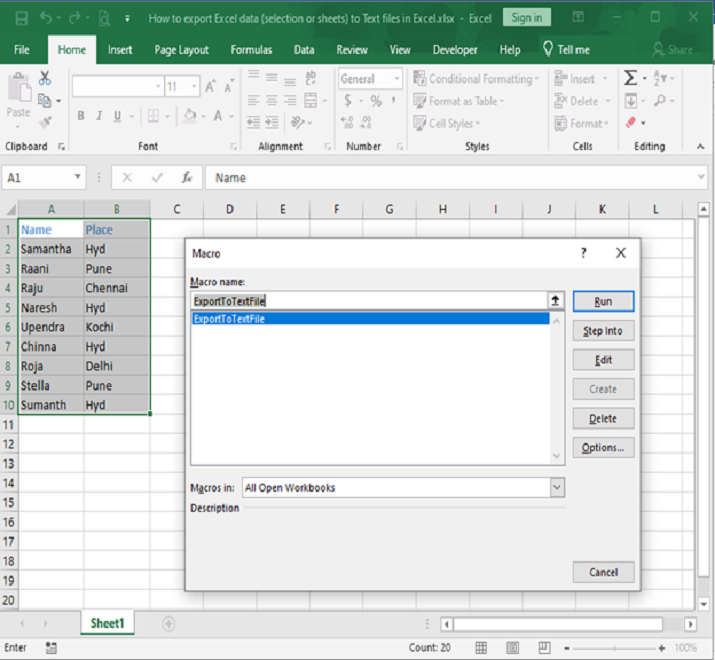
 Data Structure
Data Structure Networking
Networking RDBMS
RDBMS Operating System
Operating System Java
Java MS Excel
MS Excel iOS
iOS HTML
HTML CSS
CSS Android
Android Python
Python C Programming
C Programming C++
C++ C#
C# MongoDB
MongoDB MySQL
MySQL Javascript
Javascript PHP
PHP
- Selected Reading
- UPSC IAS Exams Notes
- Developer's Best Practices
- Questions and Answers
- Effective Resume Writing
- HR Interview Questions
- Computer Glossary
- Who is Who
How to Export Excel Data (Selection or Sheets) to Text Files
To export Excel data to text files in Excel, you can utilize VBA macros. By following a few simple steps, you can create a macro that exports either a selected range or entire sheets to a text file. The macro converts the data in the cells into a text format, loops through each cell, and builds the text data. It then prompts the user to choose a file name and location for saving the text file. Once saved, a message is displayed to confirm the successful export. With this method, you can easily export Excel data to text files for further analysis or sharing.
Steps to Export Excel Data to Text Files
Here are the steps of how you can do it:
Step 1
Open the Excel file in which you want to export excel data to text files.
Press Alt + F11 to open the Visual Basic Editor in Excel.
Insert a new module by clicking on "Insert" and selecting "Module."
In the module window, paste the following code:
Sub ExportToTextFile()
Dim SaveFileName As Variant
Dim FilePath As String
Dim TextData As String
Dim SelectedRange As Range
' Set the default file name and path
SaveFileName = Application.GetSaveAsFilename(InitialFileName:="ExportedData",
FileFilter:="Text Files (*.txt), *.txt")
' Check if user canceled the save dialog
If SaveFileName = False Then Exit Sub
' Get the selected range or entire active sheet
On Error Resume Next
Set SelectedRange = Selection.SpecialCells(xlCellTypeVisible)
On Error GoTo 0
If SelectedRange Is Nothing Then
Set SelectedRange = ActiveSheet.UsedRange
End If
' Loop through each cell in the range and build the text data
For Each Cell In SelectedRange
TextData = TextData & Cell.Value & vbTab
Next Cell
' Remove the last tab character
TextData = Left(TextData, Len(TextData) - 1)
' Get the file path from the save file name
FilePath = Left(SaveFileName, InStrRev(SaveFileName, ""))
' Create a new text file and write the data
Open SaveFileName For Output As #1
Print #1, TextData
Close #1
' Show a message when the export is completed
MsgBox "Data exported to " & SaveFileName, vbInformation
End Sub

Step 2
Save the module and close the VBA editor.
Now, you can use the macro to export data to a text file.
Select the range of cells you want to export, or make sure the active sheet contains the data you want to export.
Step 3
Press "Alt + F8" to open the macro dialog box.
Select the "ExportToTextFile" macro from the list and click "Run"

Step 4
Choose a file name and location to save the text file.

Conclusion
To export Excel data to text files in Excel, you can use VBA macros. By inserting the provided code into a module in the VBA editor, you can create a macro called "ExportToTextFile." This macro allows you to select a range or export the entire active sheet to a text file. After running the macro, a save dialog prompts you to choose a file name and location for the text file. The selected data is then looped through and written to the text file. Finally, a message box confirms the successful export. This method provides a convenient way to export Excel data to text files for further use or analysis.

